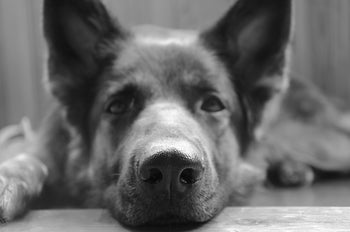Caring for Your Dog's Vision: A Guide to Eye Health!
|

Your dog's eyes are their window to the world, allowing them to explore, interact, and experience life to the fullest. Just like humans, dogs can face a variety of eye health issues that require attention and care. As a loving dog owner, it's important to be proactive in maintaining your furry friend's visual well-being. In this article, we'll delve into the essentials of eye health in dogs, from common issues to preventive measures you can take.
Understanding Canine Eye Anatomy:
To provide the best care for your dog's eyes, it's helpful to understand the basics of their anatomy. A dog's eye consists of several structures, including the cornea (clear outer layer), iris (coloured part), pupil (opening in the centre of the iris), lens (focuses light), and retina (sensory tissue that captures light). Keeping these components healthy is essential for maintaining your dog's vision.
Common Signs of Eye Problems:
Your dog's eyes can be sensitive indicators of their overall health. Be on the lookout for these signs that might indicate an eye issue:
Excessive Tearing: If your dog's eyes seem watery or teary more than usual, it could be a sign of irritation, allergies, or blocked tear ducts.
Redness or Inflammation: Red or inflamed eyes can signal infections, allergies, or other underlying problems.
Cloudiness: A hazy or cloudy appearance in the eyes may indicate cataracts or other issues affecting the lens.
Squinting or Blinking: If your dog is squinting or blinking frequently, they may be experiencing discomfort or sensitivity to light.
Visible Third Eyelid: The third eyelid becoming more visible can indicate irritation, injury, or inflammation.
Rubbing or Scratching: Excessive rubbing or scratching at the eyes might suggest discomfort or itchiness.
Maintaining Healthy Eyes:
Regular Checkups: Schedule routine veterinary checkups to ensure your dog's eyes are examined thoroughly by a professional.
Cleanliness: Gently wipe away any discharge from the corners of your dog's eyes using a damp, soft cloth.
Trim Facial Hair: Long facial hair can lead to irritation and eye problems. Regularly trim hair around your dog's eyes, ensuring it doesn't touch the eyes. Be careful not to drop the cut hair into their eye.
Diet and Nutrition: Feed your dog a balanced, nutritious diet, rich in antioxidants and Omega-3 fatty acids from sources high in DHA and EPA, as these nutrients support overall eye health.
Protect from Irritants: Keep your dog's environment with reduced levels of irritants such as smoke, dust, and pollen, which can lead to eye irritation.
Common Eye Conditions:
Conjunctivitis: Also known as "pink eye," conjunctivitis is characterized by redness, discharge, and itching. It can result from allergies, infections, or irritants.
Corneal Ulcers: Scratches or injuries to the cornea can lead to ulcers, causing pain, redness, and squinting. Immediate veterinary attention is crucial.
Cataracts: Cloudiness in the lens of the eye, known as cataracts, can develop with age. While surgery is an option, prevention through a healthy lifestyle is key.
Glaucoma: Increased pressure within the eye can damage the optic nerve, leading to glaucoma. It's a serious condition that requires prompt treatment.
Cherry Eye: The gland responsible for producing tears can become inflamed and protrude, causing a red, swollen mass to appear in the corner of the eye.
When to Seek Veterinary Care:
Prompt veterinary attention is vital when you notice any of the following signs:
Severe redness, swelling, or discharge from the eyes.
Cloudiness or changes in the appearance of the eyes.
Sudden changes in vision or behaviour.
Signs of pain or discomfort around the eyes.
Any visible injury or trauma to the eye area.
Caring for your dog's eyes is a crucial part of being a responsible and attentive pet owner. By understanding the signs of eye problems, practicing preventive measures, and seeking veterinary care when needed, you can help your furry friend maintain optimal eye health and enjoy a lifetime of clear vision. Remember, your veterinarian is your partner in ensuring your dog's well-being, so never hesitate to reach out for professional guidance and support.
Understanding Canine Eye Anatomy:
To provide the best care for your dog's eyes, it's helpful to understand the basics of their anatomy. A dog's eye consists of several structures, including the cornea (clear outer layer), iris (coloured part), pupil (opening in the centre of the iris), lens (focuses light), and retina (sensory tissue that captures light). Keeping these components healthy is essential for maintaining your dog's vision.
Common Signs of Eye Problems:
Your dog's eyes can be sensitive indicators of their overall health. Be on the lookout for these signs that might indicate an eye issue:
Excessive Tearing: If your dog's eyes seem watery or teary more than usual, it could be a sign of irritation, allergies, or blocked tear ducts.
Redness or Inflammation: Red or inflamed eyes can signal infections, allergies, or other underlying problems.
Cloudiness: A hazy or cloudy appearance in the eyes may indicate cataracts or other issues affecting the lens.
Squinting or Blinking: If your dog is squinting or blinking frequently, they may be experiencing discomfort or sensitivity to light.
Visible Third Eyelid: The third eyelid becoming more visible can indicate irritation, injury, or inflammation.
Rubbing or Scratching: Excessive rubbing or scratching at the eyes might suggest discomfort or itchiness.
Maintaining Healthy Eyes:
Regular Checkups: Schedule routine veterinary checkups to ensure your dog's eyes are examined thoroughly by a professional.
Cleanliness: Gently wipe away any discharge from the corners of your dog's eyes using a damp, soft cloth.
Trim Facial Hair: Long facial hair can lead to irritation and eye problems. Regularly trim hair around your dog's eyes, ensuring it doesn't touch the eyes. Be careful not to drop the cut hair into their eye.
Diet and Nutrition: Feed your dog a balanced, nutritious diet, rich in antioxidants and Omega-3 fatty acids from sources high in DHA and EPA, as these nutrients support overall eye health.
Protect from Irritants: Keep your dog's environment with reduced levels of irritants such as smoke, dust, and pollen, which can lead to eye irritation.
Common Eye Conditions:
Conjunctivitis: Also known as "pink eye," conjunctivitis is characterized by redness, discharge, and itching. It can result from allergies, infections, or irritants.
Corneal Ulcers: Scratches or injuries to the cornea can lead to ulcers, causing pain, redness, and squinting. Immediate veterinary attention is crucial.
Cataracts: Cloudiness in the lens of the eye, known as cataracts, can develop with age. While surgery is an option, prevention through a healthy lifestyle is key.
Glaucoma: Increased pressure within the eye can damage the optic nerve, leading to glaucoma. It's a serious condition that requires prompt treatment.
Cherry Eye: The gland responsible for producing tears can become inflamed and protrude, causing a red, swollen mass to appear in the corner of the eye.
When to Seek Veterinary Care:
Prompt veterinary attention is vital when you notice any of the following signs:
Severe redness, swelling, or discharge from the eyes.
Cloudiness or changes in the appearance of the eyes.
Sudden changes in vision or behaviour.
Signs of pain or discomfort around the eyes.
Any visible injury or trauma to the eye area.
Caring for your dog's eyes is a crucial part of being a responsible and attentive pet owner. By understanding the signs of eye problems, practicing preventive measures, and seeking veterinary care when needed, you can help your furry friend maintain optimal eye health and enjoy a lifetime of clear vision. Remember, your veterinarian is your partner in ensuring your dog's well-being, so never hesitate to reach out for professional guidance and support.








